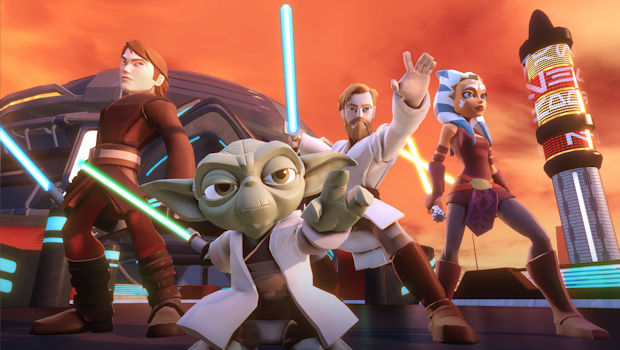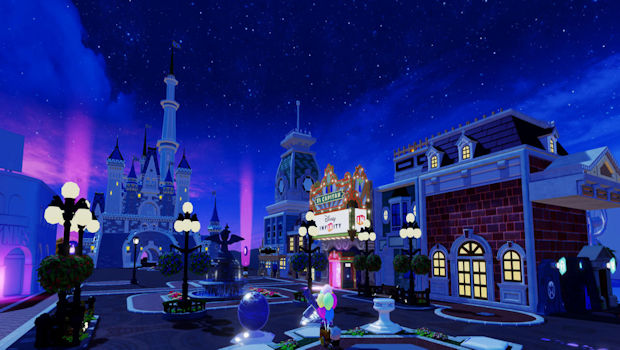2015 is a huge year for Disney. It is the year that their vision for Star Wars, which they paid $4 billion dollars for in 2012, finally comes to be. As such, Star Wars is everywhere. Toys, books, games, movies, cereal, even grapes (I shit you not). Because of this, it should not come as a big surprise that Disney has a huge focus on Star Wars in this year’s iteration of Disney Infinity, their toys-to-life franchise.
Toys-to-life, for those not in the know, is gaming and physical toys merged together to create a unique experience. Using a special portal, players see their toys (sold separately, of course) come to life on their television in the game. Each individual toy can be leveled up, and the data is stored on the physical toy itself, meaning players can take their toys with them and be able to play with the same leveled up character elsewhere just like they do at home. It’s a neat concept that mostly works.
Disney Infinity is Disney’s toys-to-life franchise, featuring all manner of Disney characters from Buzz Lightyear and Mr. Incredible to Spider-Man and Rocket Raccoon coming together on your TV. Disney Infinity 3.0, is the obvious third game in the tragically named series, and puts players in control of Anakin Skywalker, Obi Wan Kenobi, and other Star Wars characters. These characters can mingle with others (both new and old) in the all encompassing Toy Box mode, or they can go on a specialized adventure designed specifically for their set of characters.
The starter set for Disney Infinity 3.0 comes with the aforementioned Anakin Skywalker and his young padawan Ahsoka Tano, from The Clone Wars cartoon. It also comes with the Twilight of the Republic playset, the standalone adventure for the set of Clone Wars characters, which also includes Obi Wan and Yoda. Twilight of the Republic sees Anakin and company set out on a quest to determine who is putting together a droid army. While set up similarly to previous Disney Infinity playsets, Twilight of the Republic puts more emphasis on telling a cohesive story, and it generally succeeds in feeling like an episode of The Clone Wars.
The playset will see players run into a bunch of recognizable characters like General Grievous, Mace Windu, and every one’s favorite, Jar Jar Binks. The presentation is much better this time out, with actual cutscenes and voice acting that move the story forward and give players a sense of what is going on. Unlike the Avengers playset from Infinity 2.0, everything about Twilight of the Republic feels right.
That feeling extends to other areas that were previously a concern in the playsets, including mundane combat and repetitive missions. The combat has been much improved with playable characters having some actual depth to them, but the big change comes in the form of enemy A.I. Enemies now feel unique and not just reskins of the same thing over and over. They each have distinct attack patterns, and when the game throws multiple enemy types at you at the same time, combat gets really fun. Additionally, boss battles actually feel pretty good and offer more variety than your normal encounters. And missions this time around, while still very simplistic, are just better designed and offer more personality than the generic fetch, escort, or protection quests that Infinity players have been subjected to before. Add in a variety of different locales, some rudimentary space combat, and vehicle sections, and Twilight of the Republic offers the most well rounded playset for Infinity yet. But better yet, the 4-5 hour campaign is probably the best Star Wars game to come out in years.
Playsets are neat but locked to specific characters, meaning you won’t be running Minnie Mouse or Olaf through Twilight of the Republic (you can however run Star Wars Rebels and original trilogy characters through it after you collect their in game token). The mix-and-match magic mode is the Toy Box. In the Toy Box, players can take any toy they have and have them interact with the Disney Universe at large. It is also where those interested in creating their own worlds or making their own games can do so, and likewise where players can experience those created worlds and games for themselves.
Newcomers to the Toy Box will want to run through the Toy Box hub, which is a pre-created world that will set you on the path to getting the most out of the Toy Box, be it as a creator or a player. This year’s hub is a huge improvement over 2.0’s, with more refined tutorials to explain the basics of Infinity gameplay, as well as its new additions and more complex aspects. Want to learn how to combat enemies with Inside Out’s Sadness? Run through the extensive combat tutorial. Want to learn how to equip and grow a buddy, a new companion feature that gives solo players a little added protection as well as customization? Do the companion tutorials. The game has five areas that will touch on all aspects of the game, while also allowing easy access to pre-created scenarios and game modes. One scenario I sampled saw me as Anna from Frozen using turrets to shoot down Tie Fighters, it was completely absurd.
Those that want to create will have more options than ever with all new world templates, including a race track to create kart racing scenarios. I don’t get into the creation aspect of Disney Infinity much as I just don’t have the patience for a lot of it, but even I was able to quickly and easily create an engaging area with enemies and rewards. By picking a template and dragging an enemy generator and a prize generator to the field, I had an arena to do combat in and a platforming area to explore and collect orbs with experience and currency. I can only imagine that those with a sliver more patience than I would be able to create some really great stuff.
While I may not get into the level and game creation, I do very much enjoy creating my own personal game space in the form of the INterior. The INterior is basically a house creator that you can fully customize. I’ve added a secret operations base behind my rustic fantasy fireplace where I can take my characters and go spar with enemies in a combat simulation. I’ve added a room specifically for my collection of buddies where they can go and hang out when we’re not out on missions. And I plan on adding Scrooge McDuck’s Money Bin as soon as I figure out a good location for it. A Tower full of money doesn’t necessarily go with my mansion/lodge in the woods motif I have going on.
As mentioned though, even if you don’t want to create anything, Disney Infinity 3.0 offers plenty to do. Between the public-made game worlds, game modes, and scenarios and the ones created by the Infinity devs themselves, players won’t be left-wanting for content. The creation tools are so robust that someone created a working version of Nintendo’s hit shooter, Splatoon. The only limits Infinity has are those we put on ourselves.
Of course, where Disney Infinity 3.0 does so much right, there are still fundamental issues with the genre that present a huge barrier to entry for players. That, of course, is the fact that toys-to-life games are expensive and require the purchase of additional toys to bring into the world if you want to play as them and ultimately experience everything the game has to offer. At roughly $14 a piece, Infinity isn’t a cheap investment, and if you have a sick compulsion to “collect them all” like I do, it is downright scary how much money the game can have you invest.
That said, the game is fully playable and enjoyable with just the starter set and this is the best edition of the game yet. Just keep in mind that once you start playing, you’ll probably want to keep adding to the experience because those extra figures do add to the experience.



